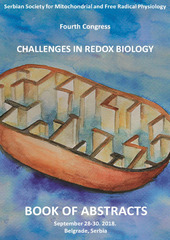Prikaz osnovnih podataka o dokumentu
Mitochondria in pachytene: the fragile point of maternal subclinical hypothyroidism affection
| dc.creator | Danilović Luković, Jelena | |
| dc.creator | Radovanovic, Anita | |
| dc.creator | Milošević, Ivan | |
| dc.creator | Lužajić, Tijana | |
| dc.creator | Milanović, Svetlana | |
| dc.creator | Kovačević Filipović, Milica | |
| dc.creator | Korać, Aleksandra | |
| dc.date.accessioned | 2023-12-06T19:52:41Z | |
| dc.date.available | 2023-12-06T19:52:41Z | |
| dc.date.issued | 2018 | |
| dc.identifier.isbn | 978-86-912893-4-8 | |
| dc.identifier.uri | http://rimsi.imsi.bg.ac.rs/handle/123456789/2698 | |
| dc.description.abstract | The stimulative effects of thyroid hormones on mitochondria are realized through both non-genomic and genomic mechanisms, affecting respiration, mitochondrial plasticity and biogenesis. The subclinical form of maternal hypothyroidism in rats induces significant reduction of mitochondria number but also an augmentation of their area in neonatal and early infantile offspring dyctiotene oocytes. This study aimed to investigate if this form of subclinical hypothyroidism affects mitochondrial morphology and distribution in the early prophase of meiosis I oocytes. It was performed on newborn control (C) (n=10) and hypothyroid (SCH) (n=10) female rat pups derived from control (n=6) and propylthiouracil treated pregnant dams (n=6), respectively. Ovaries of all pups were removed and processed for transmission electron microscopy. The morphological features of mitochondria in the early prophase I oocytes until dyctiotene were assessed. No substantial differences were found in leptotene and zygotene oocytes in SCH group comparing to control, except just a few mitochondria characterized with shortened cristae, presence of wide pale area centrally positioned and membrane disruption. Pachytene mitochondria in treated pup oocytes were in great extent with disrupted membrane, shortened cristae and wide pale area centrally positioned while these features were rarely observed in control ones. Our results confirm altered mitochondria morphology found in primordial and primary follicles in case of maternal hypothyroidism, indicating their impaired function and possibly, propensity to programmed cell death. Further investigations may indicate to what extent pachytene, as a meiotic checkpoint, appears to be a milestone possibly predetermining the future of the cell. | sr |
| dc.language.iso | en | sr |
| dc.publisher | Serbian Society for Mitochondrial and Free Radical Physiology Ministry of Education, Science and Technological Development University of Belgrade Faculty of Biology of University of Belgrade | sr |
| dc.relation | info:eu-repo/grantAgreement/MESTD/Basic Research (BR or ON)/175061/RS | sr |
| dc.rights | openAccess | sr |
| dc.rights.uri | https://creativecommons.org/licenses/by/4.0/ | |
| dc.source | Fourth Congress "Challenges in redox biology", September 28-30. 2018, Belgrade | sr |
| dc.subject | pachytene | sr |
| dc.subject | mitochondria | sr |
| dc.subject | subclinical maternal hypothyroidism | sr |
| dc.subject | rat | sr |
| dc.subject | oocytes | sr |
| dc.subject | ovary | sr |
| dc.subject | cell death | sr |
| dc.subject | TEM | sr |
| dc.title | Mitochondria in pachytene: the fragile point of maternal subclinical hypothyroidism affection | sr |
| dc.type | conferenceObject | sr |
| dc.rights.license | BY | sr |
| dc.citation.epage | 57 | |
| dc.citation.spage | 57 | |
| dc.identifier.fulltext | http://rimsi.imsi.bg.ac.rs/bitstream/id/6684/ssmfrp-conference2018-JDL-2-7.pdf | |
| dc.identifier.rcub | https://hdl.handle.net/21.15107/rcub_rimsi_2698 | |
| dc.type.version | publishedVersion | sr |

